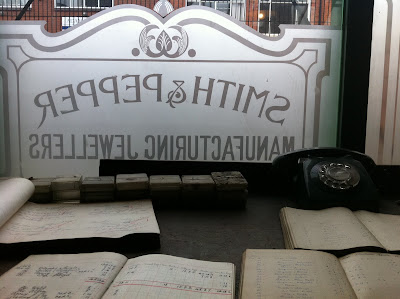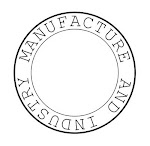
Group Design is the name of Hackney based design duo Richard Wells (above right) and Jeremy Schotte (above left). I visited them on a Saturday in July and heard about how they started up, their use of hand and machine and why now is a great time for smaller design practices.
Both Jeremy and Richard maintain full time jobs alongside their work with Group Design. Jeremy works for an architecture practice, “creating bespoke interiors and special bits of furniture.” Meanwhile Richard works for a lighting manufacturer, doing contract lighting, a background that is more, “mass production, functional,” he says.
The pair met at University of Brighton whilst doing a degree in product design. They started Group Design in 2008 out of necessity, “I feel like we didn’t actually have a choice... the desire to make things needed to be sated,” says Jeremy.
“We’d go round shows every year thinking ‘why aren’t we doing this?’ So we got the space here,” Richard adds. The space in question is in Mentmore Studios, near to London Fields, seemingly packed with other makers and designers.
The pair signed up for Tent (a London design show) in 2009 to spur themselves into producing a collection. “From January that year we were like ‘right, we’ve got to get some products’... and that’s really the range we’ve got here,” says Richard. “Some of our items are very geared towards being produced by someone else and then we have some far more labour intensive, like the Library Chair.”
Both Jeremy and Richard maintain full time jobs alongside their work with Group Design. Jeremy works for an architecture practice, “creating bespoke interiors and special bits of furniture.” Meanwhile Richard works for a lighting manufacturer, doing contract lighting, a background that is more, “mass production, functional,” he says.
The pair met at University of Brighton whilst doing a degree in product design. They started Group Design in 2008 out of necessity, “I feel like we didn’t actually have a choice... the desire to make things needed to be sated,” says Jeremy.
“We’d go round shows every year thinking ‘why aren’t we doing this?’ So we got the space here,” Richard adds. The space in question is in Mentmore Studios, near to London Fields, seemingly packed with other makers and designers.
The pair signed up for Tent (a London design show) in 2009 to spur themselves into producing a collection. “From January that year we were like ‘right, we’ve got to get some products’... and that’s really the range we’ve got here,” says Richard. “Some of our items are very geared towards being produced by someone else and then we have some far more labour intensive, like the Library Chair.”

Jeremy’s parents were antique dealers so he grew up with library chairs. When undertaking a bespoke interior for a kitchen with a high ceiling he realised that the library chair format would work perfectly. When stored it takes on the form of an everyday chair and when ‘in use’ it is a small stepladder, perfect for getting to hard to reach cupboards and shelves.
The chair’s birch plywood aesthetic neatly fits with the form of that kitchen and was originally handmade by a cabinet maker. “It should be renamed as the kitchen top cupboard chair,” says Jeremy, jokingly.

When Group Design moved to Mentmore Studios they started to work with their designs on the CNC machine which provided them with the ability to carve out the design much more quickly. “The CNC dictated some of the design. We looked at how much weight we could remove whilst retaining the strength,” says Richard.
After the CNC machine has done its bit, the pair finish the Libary Chair by hand to create a fine bit of furniture. It is a neat combination of computer and traditional craft. “I developed some jigs to help with the finishing. The process has been refined over several versions. I’ve made various components for chamfering the edges, holding bits in place,” Jeremy adds.
By combining traditional craft with modern technology Group Design manages to compete with established design brands. For Richard, with his background in mass production, this is particularly important, “I wanted to keep that accessibility and use UK manufacturing.”
Along the way they’ve found support from the likes of Metropolitan Works and Hidden Art ‘pretty invaluable’. However, they have found it tough, discovering that there were no grants to aid start-up.
As well as this support, the pair have utilised connections well to get their products into Liberty, amongst other places. Their relationship with Makers, in particular, has helped them concentrate on the design rather than the admin. “We want to gear ourselves towards being designers and start new projects when we can, rather than get bogged down with the admin of existing pieces,” Jeremy told me.
This approach is working well for them so far. Alongside the Library Chair I was also shown their Planar Shelving unit and the 490 Desk Lamp. The shelving has recently started to be stocked by Liberty.

Richard shows me the 490 Desk Lamp
(whilst Jeremy wires a plug in the background)
“To do something well you have to be interested in it. If it is using a process or some technology that is new to you, you’ll be drawn to it as you’ll be educating yourself about it and firing new lines of thought related to it,” says Jeremy when asked about their combination of old and new.
It would seem that the pair continue to spark ideas off of each other, even during our conversation, “We have an ongoing debate about how much we need to develop an idea before we can submit it to online magazines,” says Richard, “You can render things so well these days. If you look at Dezeen you see that so many things are just rendered, they’re not real products. I sometimes argue ‘why spend all the money getting it made?’ Why not just churn out idea after idea, one will stick.”
“I’m thinking of making a voting system on the site where we just chuck renders and ideas on the site. If people want something working up they vote for it. Let that drive the process a bit,” adds Jeremy.
“I think its an exciting time for small designers like us. There’s lots of new avenues that you can sell your work through or raise funding,” concludes Richard. It’s clear that they won’t run dry of ideas any time soon.
-
More photos of the visit available on the M&I Facebook page











